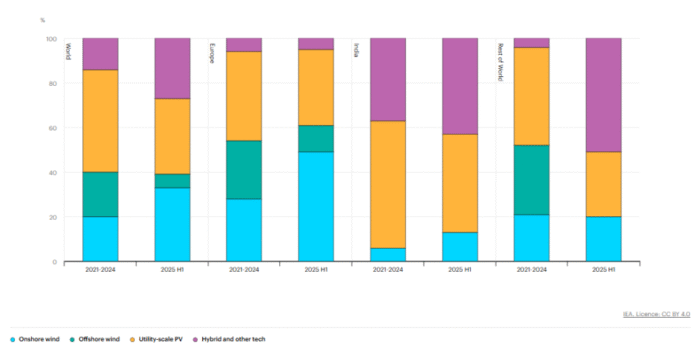The IEA Renewables 2025 Report released on October 7 revealed that global renewable energy growth faces significant headwinds over 2025‑2030.
Compared with last year, forecasts have been revised downwards by 5 percent, equating to 248 GW less capacity expected to be commissioned. Solar PV, wind power, and bioenergy deployments are all lower than anticipated, with solar PV accounting for over 70 percent of the absolute reduction and offshore wind showing the largest relative decline, down 27 percent.
The United States has seen the most severe cuts, with forecasts slashed by almost 50 percent across all technologies except geothermal. Key drivers include the phase-out of investment and production tax credits, new restrictions on foreign entities, and an executive order restricting offshore and onshore wind and solar energy projects. Wind is hit hardest, with almost 60 percent of projected capacity growth lost (57 GW), while solar PV is down nearly 40 percent.
China, despite only a 5 percent downward revision in percentage terms, suffers a 129 GW absolute reduction, the second largest globally. Policy shifts to competitive auctions and regional wholesale markets, while aimed at market integration, are expected to reduce profitability for investors, slowing deployment.
Europe also faces challenges. While utility-scale solar PV growth is slightly higher in some countries, residential projects are less economically attractive due to lower retail prices and reduced incentives post-energy crisis. Supply chain disruptions and higher costs have left offshore wind auctions without bids, resulting in project cancellations and a 24 percent downward revision.
In Latin America, curtailment risks in Brazil and Chile have led to utility-scale project cancellations, and in sub-Saharan Africa, delays in solar PV auctions and geothermal timelines have lowered forecasts by 5 percent.
Globally, the renewable sector remains off-track to meet the COP28 goal of tripling capacity by 2030, with the main case projecting 9,530 GW vs. the 11,500 GW needed. Even the accelerated case, which assumes rapid policy action, only bridges most, not all, of the ambition gap.
Electricity generation is also expected to fall short, with renewables projected to produce 850 TWh less electricity in 2030 than previously estimated. Contributing factors include the lowered capacity forecast and more conservative estimates of wind and solar PV curtailment.
Finally, while competitive auctions are driving global deployment, this market-based approach introduces higher commercial risk for developers, with lower guaranteed returns compared to traditional feed-in tariffs. In China, this shift removes stable, long-term pricing, creating uncertainty and potentially slowing investment in new projects.
Baburajan Kizhakedath

